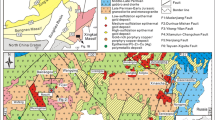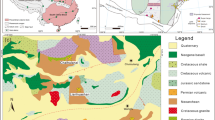Abstract
This paper presents gas compositions and H-, O-isotope compositions of sulfide- and quartz-hosted fluid inclusions, and S-, Pb-isotope compositions of sulfide separates collected from the principal Stage 2 ores in Veins 3 and 210 of the Jinwozi lode gold deposit, eastern Tianshan Mountains of China. Fluid inclusions trapped in quartz and sphalerite are dominantly primary. H-and O-isotopic compositions of pyrite-hosted fluid inclusions indicate two major contributions to the ore-forming fluid that include the degassed magma and the meteoric-derived but rock 18O-buffered groundwater. However, H- and O-isotopic compositions of quartz-hosted fluid inclusions essentially suggest the presence of groundwater. Sulfide-hosted fluid inclusions show considerably higher abundances of gaseous species CO2, N2, H2S, etc. than quartz-hosted ones. The linear trends among inclusion gaseous species reflect the mixing tendency between the gas-rich magmatic fluid and the groundwater. The relative enrichment of gaseous species in sulfide-hosted fluid inclusions, coupled with the banded ore structure indicating alternate precipitation of quartz with sulfide minerals, suggests that the magmatic fluid has been inputted to the ore-forming fluid in pulsation. Sulfur and lead isotope compositions of pyrite and galena separates indicate an essential magma derivation for sulfur but the multiple sources for metallic materials from the mantle to the bulk crust.
Similar content being viewed by others
References
Norman, D. I., Moore, J. N., Yonaka, B. et al., Gaseous species in fluid inclusions: a tracer of fluids and indicator of fluid processes, Proc. 21st Workshop Geotherm. Reservoir Eng., Stanford Univ., 1996, 233–240.
Moore, J. N., Norman, D. I., Kennedy, B. M., Fluid inclusion gas compositions from an active magmatic-hydrothermal system: a case study of The Geysers geothermal field, USA, Chemical Geology, 2001, 173: 3–30.
Wei, L., Li, X. J. Tan, J., Fluid mixing as the mechanism of formation of the Dajing Cu-Sn-Ag-Pb-Zn ore deposit, Inner Mongolia—fluid inclusion and stable isotope evidence, Science in China, Series D (in Chinese), 2002, 32(5): 405–414.
Richards, J. P., Kerrich, R., Observations of zoning and fluid inclusions in pyrite using a transmitted infrared light microscope (λ ≤ 1.9 μm), Economic Geology, 1993, 88: 716–723.
Bailly, L., Bouchot, V., Beny, C. et al., Fluid inclusion study of Stibnite using infrared microscopy: an example from the Brouzils antimony deposit (Vendee, Armorican massif, France), Economic Geology, 2000, 95: 221–226.
Foley, N. K., Bethke, P. M., Rye, R. O., A reinterpretation of the δDH2O of inclusion fluids in contemporaneous quartz and sphalerite, Creede mining district, Colorado: A generic problem for shallow orebodies? Economic Geology, 1989, 84: 1966–1977.
Lüders, V., Ziemann, M., Possibilities and limits of infrared light microthermometry applied to studies of pyrite-hosted fluid inclusions, Chemical Geology, 1999, 154: 169–178.
Li, X. J., Liu, W., Fluid inclusion and stable isotope constraints on the genesis of the Mazhuangshan gold deposit, eastern Tianshan Mountains of China, Acta Petrologica Sinica, 2002, 18(4): 551–558.
Zhou, J. Y., Cui, B. F., Xiao, H. L. et al., Evolution of the eastern segment of the Beishan rift and metallogenic regulation of gold ore deposits, Volcanology and Mineral Resources (in Chinese), 2000, 21(1): 7–16.
Cun, G., Chen, J., The Typical Gold Ore Deposits of China, Vol. 2 (in Chinese), Beijing: Geological Publishing House, 1995, 16–24.
Hu, E. Q., Zhang, J. B., Zhang, Z. G. et al., Age of pre-Cambrian metamorphic rock series and evolution of the Middle Tianshan uplifted belt in the eastern Tianshan segment—constrained by U-Pb isotope geochronology, Geochemistry (in Chinese with English abstract), 1997, 1: 23–25.
Chen, F. W., Li, H. Q., Cai, H. et al., The origin of the Jinwozi gold deposit in eastern Xinjiang—Evidence from isotope geochronology, Geological Review (in Chinese with English abstract), 1999, 45(3): 247–254.
Epstein, S., Mayeda, T., Variation of 18O content of waters from natural sources, Geochim. Cosmochim. Acta, 1953, 4: 213–224.
Clayton, R. N., O’Neil, J. R., Mayeda, T. K., Oxygen isotope exchange between quartz and water, J. Geophys. Res., 1972, B77: 3057–3067.
Liu, W., Two stages of isotopic exchange experienced by the Ertaibei granite pluton, northern Xinjiang, China, Science in China, Series D, 2000, 43: 605–616.
Wei, L., Two disequilibrium quartz-feldspar 18O/16O fractionations within the Aral granite batholith, Altay mountains of China: Evidence for occurrence of two stages of O and H isotopic exchange of a heterogeneous granite system with aqueous fluids, Journal of Petrology, 2000, 41: 1455–1466.
Hedenquist, J. W., Lowenstern, J. B., The role of magmas in the formation of hydrothermal ore deposits, Nature, 1994, 370: 523.
Lowenstern, J. B., Carbon dioxide in magmas and implications for hydrothermal systems, Mineralium Deposita, 2001, 36: 490–502.
Graney, J. R., Kesler, S. E., Gas composition of inclusion fluids in ore deposits: is there a relation to magmas? Magmas, Fluids, and Ore Deposits, Victoria, British Columbia, Mineralogical Association of Canada Short Course Series (ed. Thompson, J. F. H.), 1995, 221-245.
Giggenbach, W. F., Composition of magmatic components in hydrothermal fluids, Magmas, Fluids, and Ore Deposits, Victoria, British Columbia, Mineralogical Association of Canada Short Course Series (ed. Thompson, J. F. H.), 1995, 247-261.
Giggenbach, W. F., Geothermal gas equilibria, Geochim. Cosmochim. Acta, 1980, 44: 2021–2032.
Ohmoto,H., Stable isotope geochemistry of ore deposits, Stable Isotopes in High Temperature Geological Processes, Mineralogical Society of America, Reviews in Mineralogy (eds. Valley, J. W., Taylor, H. P. Jr., O’Neil, J. R.), 1986, 16: 528–536.
Kerrich, R., Goldfarb, R., Groves, D. et al., The characteristics, origins, and geodynamic settings of supergiant gold met-allogenic provinces, Science in China, Series D, 2000, 43(Supp.): 1.
Ohmoto, H., Goldhaber M B, Sulfur and carbon isotopes, Geochemistry of Hydrothermal Ore Deposits(ed. Barnes, H. L.), New York: Wiley, 1997, 517–599.
Zartman, R. E., Doe, B. R., Plumbotectonics—the model, Tectonophysics, 1981, 75: 135–162.
Tatsumoto, M., Knight, R. J., Allègre, C. J., Time difference in the formation of meteorites as determined from the ratio of lead 207 to lead 206, Science, 1973, 180: 1279–1283.
Ma, R. S., Shu, L. S., Sun, J. Q., Tectonic Evolution and Metallogeny of Eastern Tianshan Mountains (in Chinese with English abstract), Beijing: Geological Publishing House, 1997, 179.
Author information
Authors and Affiliations
Corresponding author
Rights and permissions
About this article
Cite this article
Wei, L., Xinjun, L. & Jun, D. Sources of ore-forming fluids and metallic materials in the Jinwozi lode gold deposit, eastern Tianshan Mountains of China. Sci. China Ser. D-Earth Sci. 46 (Suppl 1), 135–153 (2003). https://doi.org/10.1360/03dz9034
Received:
Issue Date:
DOI: https://doi.org/10.1360/03dz9034




